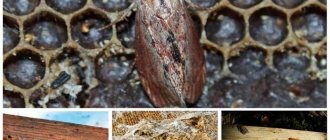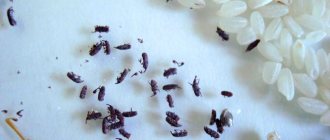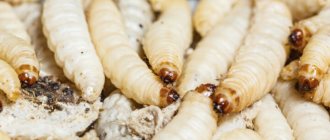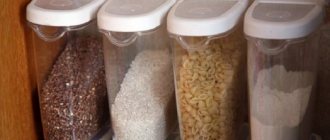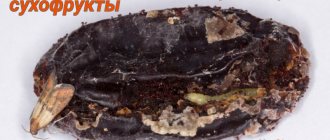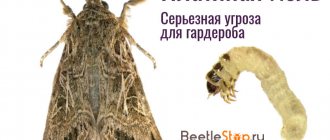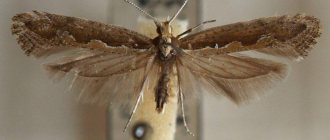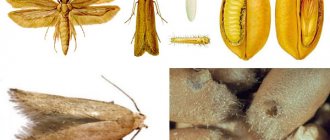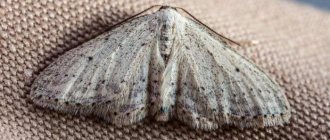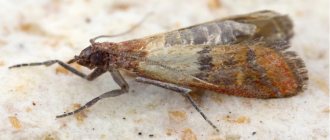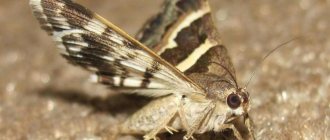When storing groceries, housewives are faced with such an unpleasant phenomenon as moths in cereals. The danger is not from adult insects, but from their larvae. They can be found in cereals, tea, flour, pasta or other grocery products.
There are moths - what to do? In such cases, modern chemicals or traditional medicine recipes that have been tested for decades are used. This method is the safest and most preferable, since chemicals and toxins are absorbed, and the cereal becomes the cause of severe human poisoning.
- Features Routes of entry
- Harm from cereal moths
- Reasons for appearance
- Garlic
- Traps
Peculiarities
If dry bulk products are stored incorrectly, then you can be sure that sooner or later food moths will appear in the cereal.
Moreover, it is not the butterfly itself that causes harm; it does not feed on reserves, but the larva. There are several varieties of moth in cereals, which differ depending on their taste preferences. However, do not delude yourself: if a moth has destroyed one grain, it very easily and with appetite moves to another.
Moths in food.
A moth is an ordinary, inconspicuous small butterfly with gray wings. Most of all she loves rice and buckwheat groats, grain or flour. But the pest will happily feast on nuts, dried fruits, oatmeal, peas or even tea.
The flying individuals themselves do not live long, about 5-6 days. They are no longer interested in food, but only in water. She hides in dark places and lays eggs. After 7-10 days, voracious larvae emerge from the eggs, which cause maximum damage to the products.
Did you come across cereal with moths?
Not really
Search for the source of infection
First of all, you need to understand what the eggs and larvae of the pest look like. The eggs are white, round and small in size; in appearance they resemble semolina grains that have stuck together.
They hatch into larvae that look like small white worms. They grow up to 1.3 cm and are ready in a dark shade. You can also see cobwebs in the rump, which is also a sign of infection.
You will need to conduct a thorough inspection of not only the products, but also the cabinets and kitchen. When examining, it is important to find not only the source of infection, but also all cereals that already contain eggs and larvae.
Remember that pests can easily chew through paper packaging, polyethylene, and foil, so the appearance of a whole package does not mean at all that the cereal in the middle does not contain larvae. Animal food, for example, for dogs, cats, birds, and even fishing food, can be contaminated; be sure to inspect it.
You should carefully inspect the ceilings, cabinets, baseboards, cabinet shelves, and all cracks. Moths are nocturnal, so during the day they prefer to hide in dark, secluded corners.
After the treatment has been carried out, you can easily check whether all the moths have been destroyed. To do this, turn on the light at night; if there are adults in the apartment, they will circle around the light source.
Harm from cereal moths
It would seem that if a butterfly does not bite or harm people, and is not a carrier of any infections, then why is it called a pest. Food moths leave larvae in cereals that feed on them. There they leave their excrement, as well as cocoons and dead flying individuals. Because of this, food becomes unusable.
Some housewives wonder whether it is possible to eat foods that contain moths.
No, it’s better not to do this and, in the event of a large-scale disaster, immediately throw away all bulk products with signs of moths. But if the first signs have just appeared, then you can remove the top layer of cereal, sort it out as much as possible and sift it to throw away all the remains of the pest. If there is anything left, dry it well in the oven.
Food moth caterpillars.
Routes of penetration
Many housewives are puzzled by the question of why moths appear in cereals. Moths can get into the house in several ways:
- With contaminated products from a market or store;
- Through a window in the absence of a mosquito net;
- Through the vent.
To minimize the risk of pest butterflies entering your apartment, it is preferable to purchase groceries in large stores rather than at street markets. It is incorrect storage conditions that contribute to the spread of the pest.
How to withdraw
It is very important to immediately move on to pest control as soon as its first signs are detected. If there are moths in the cereal, you must:
- Eliminate the breeding site of caterpillars, sift or sort the bulk grains by hand.
- If larvae are noticed, the groceries will have to be thrown away; they can pose a health hazard to both people and pets.
Proper storage is the key to food safety.
- For prevention, all cereals can be calcined on a dry sheet in the oven or frozen in the refrigerator for a couple of days.
- To clean up your closet, you need to remove everything from there, and then thoroughly wipe all the shelves and corners of the cabinets with clean water and vinegar or laundry soap.
An important condition is the correct storage of bulk products in sealed jars.
Fighting methods
Getting rid of food moths is not easy, because you need to destroy not only the adults lazily fluttering around the kitchen and the entire apartment, but also their larvae and eggs.
Control of adult grain moths
Purchase sticky traps designed specifically for moths. They are impregnated with a special composition, the smell of which attracts butterflies. Hang these strips in the pantry, in kitchen cabinets, and do not forget to change them periodically.
Important! Moths fly out to lay eggs in March-February; it is during this period that traps will come in handy more than ever.
Destruction of larvae and eggs
How to remove food moths from the products themselves?
Do an audit in the kitchen. Carefully sort through all the bags and jars of cereals and flour in the house, examine sweets and even animal food to be sure. If you see larvae or lumps with cobwebs in buckwheat, semolina, immediately throw away such grains so that the pest does not spread further throughout the apartment. Urgently pour products uninfected with larvae into tightly closed containers, preferably glass, so that from time to time you can freely examine the contents without opening the jars. Infected flour can be cleaned of larvae by sifting it through a fine sieve. Try not to leave such garbage in the kitchen; immediately throw it away from the house. The fight continues!
If you are not very sure about the quality of other products, overcook them in the oven. Spread the cereal in a thin layer on a sheet, keep in an oven preheated to 70° C for about an hour, do not forget to stir. When the cereal has cooled, hide it in prepared jars and close tightly. To combat moths, freezing is also suitable, giving the same effect. You need to keep the bags of cereals in the freezer for a couple of days and, after pulling them out, wait until all the condensation disappears.
Do not eat contaminated cereals or legumes, even after frying and freezing: such treatment destroys moths, but does not cleanse the food of its waste products.
Give your kitchen cabinets a deep clean. Empty all shelves, remove any remaining loose products, and thoroughly clean corners, hinges, holes and crevices. Be sure to check if you have missed any lumps of cobwebs. Wash the vacated shelves and walls with soapy water, then you can use insecticides. Spray the spray, thoroughly go through all the cracks, door hinges, secluded places, remove excess foam with a napkin. Be sure to ventilate the kitchen after treating with insecticide and do not even think about using it on cereals or storage containers! Vinegar is also suitable for fighting insidious grain moths at home, so if there are no special anti-moth products, at the end of cleaning, moisten the surface with a vinegar solution, do not forget to wash the back walls and tops of cabinets. Dry everything thoroughly, because moths love to lay eggs in damp, dark places.
Folk remedies
Folk remedies are effective and safe for people and pets. That is why housewives resort to them first. Here are several ways to get rid of cereal moths.
| Strawberry soap and lemon or orange peels | As you know, citrus peels emit a bright aroma that moths cannot tolerate. This repellent will reliably protect things and textiles from uninvited guests and scent items in the closet. |
| Black and allspice, tobacco, cloves, rosemary | The spicy smell of allspice and other seasonings effectively repels moths and creates an unfavorable environment for breeding offspring. |
| Laundry soap | Potato and clothes moths cannot live normally and produce offspring if laundry soap is nearby. |
| Vinegar and garlic | Diluted vinegar is often used to treat cabinets for preventive purposes. Placing garlic cloves in boxes works the same way. Butterflies cannot tolerate the persistent, aromatic root vegetable. |
| Fir oil | A study of essential oils showed that fir oil was effective in the fight against domestic insects. Apply the oil to a cotton pad and wipe the surfaces where traces of moths have been noticed. |
| Caucasian chamomile | This product is used in dry form - sachets of several grams are made and laid out around the apartment. |
| Chestnuts | Dried chestnuts are used to layer clothes and home textiles, thus preventing the appearance of butterflies. |
| Houseplants coleus (nettle) and geranium (pelargonium) | These indoor flowers have a bright aroma that insects cannot tolerate. Flowers placed around the room will repel insects and will not provide comfort for reproduction. |
| Lavender | The fastest way to get rid of moths and other pests in the house is lavender and its oil. It has long been known that sprigs should be kept in all wardrobes, and lavender oil should also be used on surfaces and upholstered furniture. |
| Sagebrush | The smell of wormwood twigs has an unusual property: it can disorient adult moths in space, thus the life cycle is disrupted and the pests disappear. |
| Newspapers | Printing ink is known to repel insects. Thus, things arranged with newspapers will remain untouched by harmful insects. |
| Vinegar | To treat surfaces with vinegar, you need to heat two tablespoons, then place the hot liquid in a cabinet for about 10 minutes. This time is enough to kill both larvae and adults with acid vapor. |
What does it eat and what is it afraid of?
The kitchen moth is practically omnivorous. She eats not only groceries, but also fresh fruits, and even dried herbs or spices. Adult flying individuals do not feed at all: they lack mouthparts and a digestive system. The threat is posed by food moth larvae, which require a lot of food to pupate.
The following products are at risk:
- Cereals – semolina, rice, millet, buckwheat.
- Pasta.
- Cereals – oat flakes, seeds, bran.
- Dried fruits – prunes, dried apricots, raisins, figs.
- Flour and bakery products: baked goods, cookies, crackers.
- Cocoa and mild spices.
- Nuts – hazelnuts, almonds, cashews.
- Sugar.
Food moths cannot tolerate the smell of citrus fruits, lavender, tansy, wormwood, rosemary, dill, and cloves. Therefore, for preventative purposes, you can hang dried bouquets of herbs in the kitchen or use essential oils - to scent the air, wipe cabinets, add to water when wet cleaning.
Stages of transformation into food moth from eggs.
Store funds
Store-bought products are effective, but you need to be careful with them, because they can harm human health. They are not recommended for use on cereals.
Traps
Moth trap.
There are special insect traps on sale. They are safe for food because they do not emit toxic substances. It contains pheromones that are extremely attractive to moths.
The butterfly flies to the smell and lands on a sticky surface, from which it is no longer possible to escape. On average, one trap lasts for 3-4 months. The main thing is that it can be placed near food products.
Chemicals
There are aerosols, adhesive tapes or special dry powders, which, according to the instructions, must be used by spraying or installing where pest activity has been noticed. The most effective are Armol, Raid, Raptor or Clean House.
Anti-moth preparations.
Where did food moths come from in your kitchen?
There can be many reasons for this, and some of them do not even depend on you. In particular, moths can appear even in hermetically sealed food products if they are not properly maintained in warehouses or production facilities. For example, this is a violation of storage temperature, high humidity or lack of ventilation in the room, improper preliminary preparation of raw materials or storage.
Partially, these reasons “work” in your kitchen. If the room is too hot or, conversely, the humidity or air temperature is too high, favorable conditions have been created for the appearance of the pest. In cool and ventilated dry rooms, moths are much less likely to appear. Another reason for the appearance of moths is the storage of expired cereals, flour and other types of food in cupboards, as well as spoiled dried fruits and dried berries, dried medicinal plants and mushrooms.
Prevention measures
- It is best not to buy food supplies of bulk products in large quantities, because this is extremely attractive to moths. However, if you still have to make supplies, then you need to purchase them in trusted stores. It happens that even on an industrial scale, moths can severely damage grocery supplies.
- If there is a suspicion that the products have been under the influence of a pest and may be contaminated, then it is better to bake them or leave them in the freezer for a couple of days. Food products should be stored in tightly closed jars. These can be metal or plastic containers.
- It is important to regularly wet clean all kitchen elements. This applies to lockers. All corners, shelves and doors need to be thoroughly washed. If there is ventilation in the kitchen, then the grilles should have mosquito nets. This way you can protect your kitchen from moths, as well as from cockroaches, bedbugs and other insects.
It is best not to create favorable conditions for moths and not to store dried fruits, groceries and tea nearby.
Is it possible to eat contaminated foods?
Experts categorically do not recommend using contaminated cereals for cooking. If you see a butterfly in the kitchen, find its offspring and destroy it along with the supplies in which it was founded. The faster you do this, the more food will survive. Kitchen moth larvae gnaw through packages and eat their contents at an enviable speed, infecting everything around with their waste, dead individuals and chitinous shells. Once in the human body, such food can cause the development of a serious allergic reaction.
Bottom line
The appearance of moths in bulk food products is, of course, unpleasant, but not critical. This can be prevented using simple and accessible preventive measures. If the moment is missed and you have to deal with insects that have already appeared, then you will need to start with gentle measures that will be safe for food and human health. Simple, cheap and effective means of control are always at hand.
Previous
MolesWhat moths are afraid of: getting rid of pests in 10 different ways
Next
Moth Moth trap: review of manufacturers and DIY production
